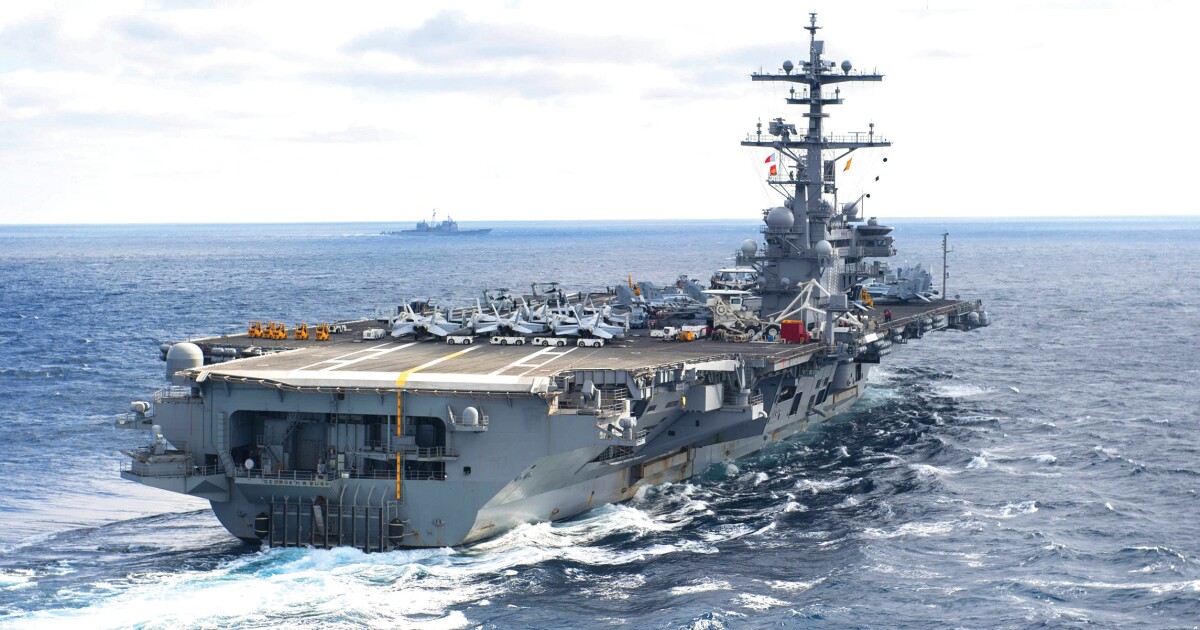

The Navy is enjoying a burst of positive PR, basking in the glow of the feel-good summer blockbuster sequel Top Gun: Maverick, in which the ageless Tom Cruise recreates his iconic role as the hotshot fighter jock Pete “Maverick” Mitchell.
The original Cold War-era Top Gun, released in 1986, was beloved by the Navy, as it motivated a bumper crop of new recruits.
Now, 36 years later, facing a pilot shortage, the Navy is hopeful history repeats itself.
But the reality of life in the Navy these days, especially for the enlisted sailors who work below decks, is a far cry from the Hollywood chimera of adrenaline-fueled thrill rides interspersed with sexy beach volleyball games.
Take, for example, the roughly 2,700 sailors assigned to the USS George Washington, which is halfway through a five-year overhaul and won’t be put to sea until sometime in 2023.
Many of the crew members live off the ship and commute to work, but for the most junior sailors who have no place to go, daily life is a high-stress grind of marathon workdays and sleepless nights in a nonstop construction zone.
In April, three sailors from the GW committed suicide in a single week, including Xavier Sandor, 19, who resorted to sleeping in his car after his 12-hour shifts and whose father told NBC News that when he urged his son to seek help, he replied, “Dad, they don’t give a f***. They don’t care.”
The spike in suicides shone a harsh light on a growing mental health crisis prompted by soul-crushing working conditions and prompted the Navy to move 200 sailors who had been living on the carrier to new accommodations on shore.
Hannah Crisostomo, an aviation boatswain’s mate handler on the carrier, attempted suicide last year after she was put on night-shift repair duties and saw no way out of her five-year commitment.
“There is no putting in your two-week notice and getting out,” Crisostomo told NBC, saying that when she sought help, she was belittled by her superiors.
In the immediate aftermath of the suicides, the Navy sent a team of psychiatric counselors to the ship, expedited mental telehealth appointments and referrals, and dispatched its senior enlisted leader to give a combination pep talk/reality check to the ship’s crew.
“If you’re less happy because you don’t feel like you’re doing the thing that you came here to do … It’s not optimal. We know that,” said Master Chief Petty Officer Russell Smith, according to a Navy transcript of his all-hands meeting with the sailors to discuss what he called the “shit you have to go through” when serving on a ship at a dry dock.
Yes, Smith said, “parking sucks,” the food is not “gourmet,” and sometimes, they have to turn the water off and shut down “some of the other hotel services” on the carrier — but, he said, at least you’re not “sleeping in a foxhole like a Marine.”
“I think we probably could have done better to manage your expectations,” Smith admitted. “You’re trying to fix a warship … When someone walks by you at Starbucks when you’re in uniform and says ‘thank you for your service,’ this is one of the things that they’re thanking you for.”
In congressional testimony last month, Navy Secretary Carlos Del Toro said there was “no greater responsibility” than the safety of sailors and Marines and was decidedly more sympathetic to the isolation and stress that the crew of the George Washington experienced over several years.
“Shipyard life itself is challenging enough. When you’re in the shipyard that long, that presents additional challenges,” Del Toro told the Senate Armed Services Committee. “We need to collectively do a better job to provide the necessary resources … to provide a higher quality of life for those sailors in the shipyard.”
The Navy has three investigations looking into what went wrong aboard the carrier, but the morale and mental problems were well known before the spate of suicides.
A February GAO report spotlighted the harsh realities of life on U.S. Navy ships that are in port for repairs and included first-hand accounts from sailors who were overworked and fatigued.
“Ships’ crews described operating in unsafe conditions, with safety measures circumvented or disregarded, and working 12 to 20 hours while in port, canceling leave, and also working long shifts in order to get maintenance done while underway,” the report said.
See: “A sailor’s life: Overworked, undertrained, understaffed, stressed out,” Washington Examiner magazine, March 1.
And it’s not just sailors in port who are stressed to the max.
A damning investigation into how a Seawolf-class attack submarine, the USS Connecticut, rammed an undersea mountain last October concluded that the mishap, which could have sunk the $2.4 billion boat, would have been easily prevented by “prudent decision-making and adherence to required procedures.”
The accident was blamed on the poor seamanship of the skipper, his deputy, and four other crew members who, while nominally qualified, made for “a particularly weak team,” according to the investigation. All six lost their jobs.
Eleven crew members were injured, and 50 of the 116-member crew were so traumatized from the near-undersea disaster that the ship’s medic advised they would “benefit from mental health treatment.”
Overworking and fatigue were not cited as factors in the submarine accident but are judged to have contributed to two separate at-sea collisions in 2017 involving the USS Fitzgerald and the USS John S. McCain.
And the harsh working conditions pier-side may have contributed to the 2020 fire that destroyed the amphibious assault ship USS Bonhomme Richard as it was undergoing maintenance in San Diego.
A junior sailor charged with setting the ship ablaze goes to trial in September.
At a House Armed Services Committee hearing in April, Rep. Jackie Speier (D-CA) quizzed Joint Chiefs Chairman Gen. Mark Milley about the troubling trend.
“The GAO reports that sailors are working 80 to 100 hours per week and sleeping less than six hours a night, and they’re struggling with mental health,” she said. “We saw it on the Fitzgerald, we’ve seen it in the ship that was destroyed, the $4 billion ship in San Diego. What are we going to do to get the Navy to take this seriously?”
“I think the Navy does take it seriously. It’s not a simple solution. It has to do with OPTEMPO [operational tempo],” Milley replied. “They’re running hard, and we ask an awful lot of our Navy, as we do the Army and the Air Force, but the Navy is particularly stressed because we extend ships, and they’re out there for extended periods of time … Their manning levels are lower per ship than optimally manned, so that’s a problem.”
Defense Secretary Lloyd Austin says he’s fully focused on the mental health and suicide problems in the military, and in March, he established an independent review committee to help better understand suicide, prevent it, and treat the unseen wounds that lead to it.
As for the hell experienced by junior sailors during the repairs to George Washington, Austin testified last month, “There are choices that have been made or will be made in the future in terms of how to billet sailors when that repair is ongoing … [It] certainly was not anticipated that the ship would be in a repair cycle this long. But nonetheless, I expect the leadership to make the right decisions. And I look forward to seeing what the investigations are going to show us.”
Jamie McIntyre is the Washington Examiner’s senior writer on defense and national security. His morning newsletter, Jamie McIntyre’s Daily on Defense, is free and available by email subscription at dailyondefense.com.





